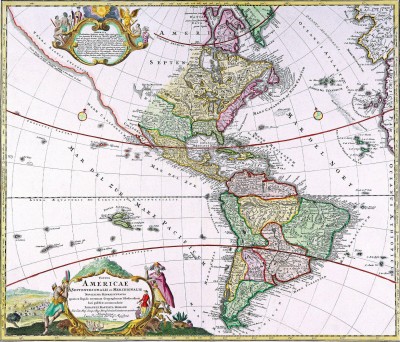How to create personalized, annotated, customized maps using Google Maps.
The Art of Maps:Johann Baptiste Homann [California as an Island]
Johann Baptiste Homann – Title: Totius Americae Septentrionalis et Meridionalis Novissima Representatio . . . [California as an Island]
Map Maker: Johann Baptiste Homann
Place / Date: Nuremberg / 1710
Coloring: Hand Colored
Size: 22.5 x 19 inches
Condition: VG
Price: $1,800.00
Description:
Striking dark impression of the first edition JB Homann’s map of America, showing California as an Island on the second Sanson model and pre-datingHomann’s privilege.
The Straits of Anian are shown forming a Northwest Passage between California and the mythical Terra Esonis, which forms a nearly continuous land bridge from the Northwest to Asia. The Pays de Moozemleck is shown east of the Straits of Anian. This landmark remains virtually unchanged through all of Homann’s maps of America, despite the transition to a peninsular California, resulting in an odd change from a coastal to an apparently landlocked position for this landmark.
The Great Lakes are shown with some detail. The Mississippi River shows the results of the early French Jesuit explorations, with its sources extending far North of the limits of the maps produced 20 and 30 years earlier, although Le Moyne’s mythical lake in the Southeastern US remains. The title cartouche is based upon De Fer’s landmark map of 1699. The top cartouche is based upon De L’Isle’s 1703 map of Canada.
Fine dark impression, reflecting a very early pull fom the copperplate.
Condition Description: Old Color. Minor fold split at bottom centerfold and minor tear to the left of the fold, repaired on verso.
Android 2.3 Platform and Updated SDK Tools
 Today we’re announcing a new version of the Android platform — Android 2.3 (Gingerbread). It includes many new platform technologies and APIs to help developers create great apps. Some of the highlights include:
Today we’re announcing a new version of the Android platform — Android 2.3 (Gingerbread). It includes many new platform technologies and APIs to help developers create great apps. Some of the highlights include:
- Enhancements for game development: To improve overall responsiveness, we’ve added a new concurrent garbage collector and optimized the platform’s overall event handling. We’ve also given developers native access to more parts of the system by exposing a broad set of native APIs. From native code, applications can now access input and sensor events, EGL/OpenGL ES, OpenSL ES, and assets, as well a new framework for managing lifecycle and windows. For precise motion processing, developers can use several new sensor types, including gyroscope.
Rich multimedia: To provide a great multimedia environment for games and other applications, we’ve added support for the new video formats VP8 and WebM, as well as support for AAC and AMR-wideband encoding. The platform also provides new audio effects such as reverb, equalization, headphone virtualization, and bass boost.
New forms of communication: The platform now includes support for front-facing camera, SIP/VOIP, and Near Field Communications (NFC), to let developers include new capabilities in their applications.
For a complete overview of what’s new in the platform, see the Android 2.3 Platform Highlights.
Alongside the new platform, we are releasing updates to the SDK Tools (r8), NDK, and ADT Plugin for Eclipse (8.0.0). New features include:
- Simplified debug builds: Developers can easily generate debug packages without having to manually configure the application’s manifest, making workflow more efficient.
Integrated ProGuard support: ProGuard is now packaged with the SDK Tools. Developers can now obfuscate their code as an integrated part of a release build.
HierarchyViewer improvements: The HierarchyViewer tool includes an updated UI and is now accessible directly from the ADT Plugin.
Preview of new UI Builder: An early release of a new visual layout editor lets developers create layouts in ADT by dragging and dropping UI elements from contextual menus. It’s a work in progress and we intend to iterate quickly on it.
To get started developing or testing applications on Android 2.3, visit the Android Developers site for information about the Android 2.3 platform, the SDK Tools, the ADT Plugin and the new NDK.
Check out the video below to learn more about the new developer features in Android 2.3.
